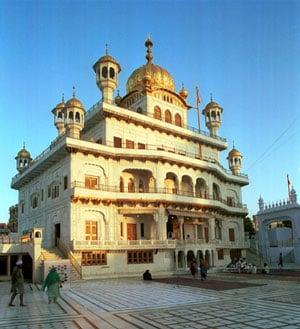Template:AOW44: Difference between revisions
Hari singh (talk | contribs) No edit summary |
Hari singh (talk | contribs) No edit summary |
||
| Line 1: | Line 1: | ||
{{aowh|Akal Takhat}} | |||
[[Image:Akal-takhat-2.jpg|thumb|right|{{cs|'''The Akal Takhat in the morning as the sun rises'''}}]] | |||
'''Akal Takhat''' (Punjabi: <big>ਅਕਾਲ ਤਖ਼ਤ</big>, Akĝl Taḵẖt) means the ''Throne of the Immortal'' and is the highest political institution of the [[Sikh]]s. "Akal" means ''"The Timeless One"'' - another term for God. "Takhat" means ''"throne"'' in Persian. The Akal Takhat is an impressive building that sits directly in front of the causeway leading to the [[Golden Temple]] in [[Amritsar]]. The Akal Takhat was founded by [[Guru Hargobind]] on June 15, 1606 (now celebrated on '''July 2, every year''') and was established as the place from which the spiritual and temporal concerns of the Sikh community could be acted upon. | |||
It stood as a symbol of political bulwark against the [[Mughal]] Emperors in the 17th and 18th century. Various attacks on the Akal Takhat and [[Harimandir Sahib]] have been led in the past by [[Ahmed Shah Abdali]] and Massa Rangar in the 18 century. On June 4, 1984, the Indian Army damaged the outer facade of the Akal Takhat while attempting to flush out Sikh militants in a controversial military operation known as [[Operation Bluestar]]. <big>'''[[Akal Takhat|....More]]'''</big> | |||
Revision as of 20:07, 25 June 2007
Akal Takhat (Punjabi: ਅਕਾਲ ਤਖ਼ਤ, Akĝl Taḵẖt) means the Throne of the Immortal and is the highest political institution of the Sikhs. "Akal" means "The Timeless One" - another term for God. "Takhat" means "throne" in Persian. The Akal Takhat is an impressive building that sits directly in front of the causeway leading to the Golden Temple in Amritsar. The Akal Takhat was founded by Guru Hargobind on June 15, 1606 (now celebrated on July 2, every year) and was established as the place from which the spiritual and temporal concerns of the Sikh community could be acted upon.
It stood as a symbol of political bulwark against the Mughal Emperors in the 17th and 18th century. Various attacks on the Akal Takhat and Harimandir Sahib have been led in the past by Ahmed Shah Abdali and Massa Rangar in the 18 century. On June 4, 1984, the Indian Army damaged the outer facade of the Akal Takhat while attempting to flush out Sikh militants in a controversial military operation known as Operation Bluestar. ....More

